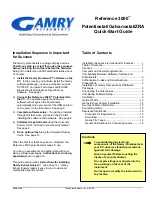
Model 2651A High Power System SourceMeter® Instrument Reference Manual
Section 7: Command reference
2651A-901-01 Rev. A / March 2011
7-17
Details
Assigning a value to this attribute enables or disables the buffer append mode. This value can only be changed
with an empty buffer. Use
bufferVar
.clear()
to empty the buffer.
With append mode on, the first new measurement will be stored at
rb[n+1]
, where
n
is the number of readings
stored in buffer
rb
.
See the
smu
X
.nvbuffer
Y
attribute for details on accessing dedicated reading buffers.
Example
smua.nvbuffer1.appendmode = 1
Append new readings to contents of
dedicated reading buffer 1.
Also see
(on page 7-201)
(on page 7-238)
(on page 3-6)
bufferVar.basetimestamp
This attribute contains the timestamp of when the first reading was stored in the buffer.
Type
TSP-Link accessible
Affected by
Where saved
Default value
Attribute (R)
Yes
Not applicable
Not applicable
0
Usage
basetime
=
bufferVar
.basetimestamp
basetime
The timestamp of the first stored reading
bufferVar
The reading buffer; can be a dynamically allocated buffer (user-defined), or a
dedicated reading buffer (such as
smua.nvbuffer1
)
Details
This read-only attribute contains the timestamp (in seconds) of the first reading stored in a buffer (
rb[1]
stored
in reading buffer
rb
). The timestamp is the number of seconds since 12:00 AM January 1, 1970 (UTC) that the
measurement was performed and stored.
See the
smu
X
.nvbuffer
Y
attribute for details on accessing dedicated reading buffers.
Example
basetime = smua.nvbuffer1.basetimestamp
print(basetime)
Read the timestamp for the first reading
stored in dedicated reading buffer 1.
Output:
1.2830e+09
The above output indicates that the
timestamp is 1,283,000,000 seconds (which
is Saturday, August 28, 2010 at 12:53:20
PM).
















































